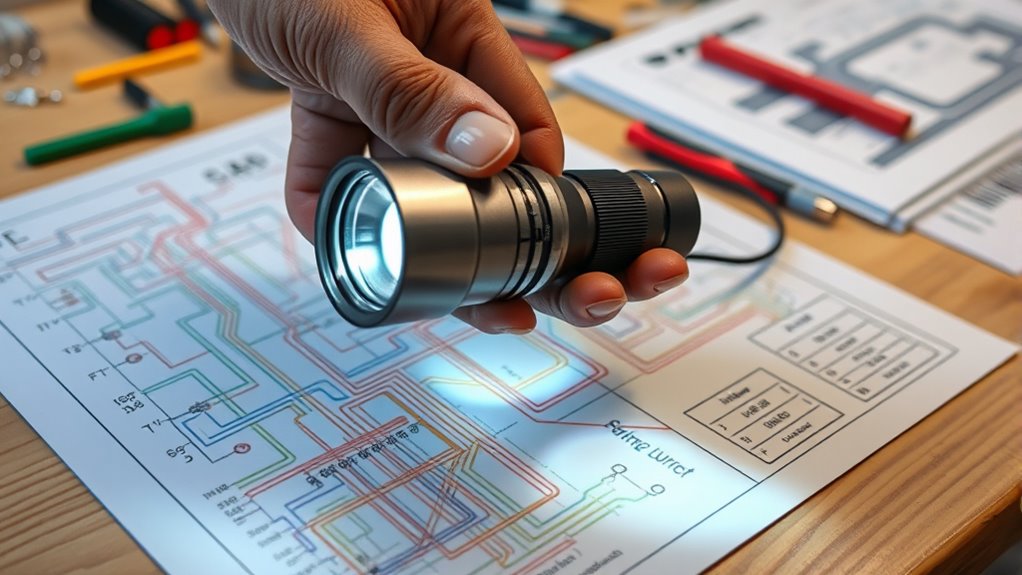To understand a wiring diagram, start by familiarizing yourself with standard circuit symbols, which represent different components like switches, resistors, and power sources. Pay attention to the color codes, such as red for hot wires, white for neutral, and green for ground, to identify wire purposes. Follow the connections shown in the diagram to see how components interact. If you keep exploring, you’ll gain clearer insights into interpreting these diagrams with confidence.
Key Takeaways
- Familiarize yourself with standard circuit symbols and consult the diagram’s legend or key.
- Follow the color codes to identify wire functions and ensure correct connections.
- Trace the circuit flow step-by-step from the power source through components to the load.
- Pay attention to connections, junctions, and line patterns to understand how components are linked.
- Practice interpreting various diagrams to improve recognition of symbols and color schemes over time.

Ever wondered how to interpret a wiring diagram accurately? It’s a skill that can save you time and prevent costly mistakes, especially when working on electrical projects. The first step is understanding the fundamental elements: circuit symbols and color codes. Circuit symbols are standardized icons representing different electrical components like switches, resistors, transformers, and power sources. Familiarizing yourself with these symbols is essential because they convey complex information in a simplified visual form. Each symbol has a specific shape and lines that indicate how components connect, so studying a legend or key included with the diagram can help you decode what each symbol means. Once you recognize the symbols, you can follow the flow of the circuit more easily, tracing how electricity travels through the system. Recognizing common circuit symbols helps you interpret diagrams more intuitively and accurately.
Color codes play a significant role in identifying wiring and ensuring proper connections. Different colors are used for wires to distinguish their purpose or voltage level. For example, black or red wires often indicate hot or live connections, while white or gray wires are typically neutral. Green or bare copper wires are used for grounding. When reading a wiring diagram, pay close attention to these colors, as they guide you in matching the diagram to real-world wiring. This reduces errors and ensures safety when installing or troubleshooting circuits. Manufacturers or standards organizations usually provide a color code chart, which you should keep handy. By correlating these colors on the diagram with actual wires, you can confidently identify which wire does what, making your work more precise.
Understanding how circuit symbols and color codes work together makes reading a wiring diagram much more straightforward. You’ll be better equipped to visualize the circuit’s layout, identify potential issues, and implement repairs correctly. Remember that diagrams are blueprints—like a map guiding you through an unfamiliar territory—so mastering these symbols and color schemes is your key to steering it efficiently. Take your time to familiarize yourself with common symbols and color conventions before diving into complex diagrams. With practice, you’ll quickly become adept at interpreting diagrams, saving you frustration and ensuring your electrical projects are both safe and successful. Ultimately, a clear understanding of these basics transforms a confusing jumble of lines and symbols into a logical, manageable plan—empowering you to work confidently with electrical systems.
Frequently Asked Questions
What Tools Do I Need to Read a Wiring Diagram Effectively?
You need a few essential tools to read a wiring diagram effectively. Keep a multimeter handy to test connections, and use a flashlight for better visibility in detailed diagrams. Familiarize yourself with color coding, which helps identify wires quickly, and consult schematic legends for symbols and abbreviations. Having these tools and knowledge allows you to interpret wiring diagrams accurately, ensuring safe and efficient electrical work.
How Do I Identify Different Symbols in a Wiring Diagram?
You identify different symbols in a wiring diagram by consulting the symbol legends, which explain each icon’s meaning. Pay attention to color codes, as they help distinguish wire types and connections. By matching symbols to their descriptions in the legend and noting color codes, you can accurately interpret the diagram. This approach makes troubleshooting and installation easier, ensuring you understand the circuitry clearly and work safely.
Can Wiring Diagrams Vary Between Different Electrical Systems?
Imagine wiring diagrams as musical scores, where different systems play their own tune. Yes, they can vary between electrical systems because of different electrical standards and system variations. These differences influence symbols, colors, and connections, making each diagram unique. When you approach a new diagram, you’re tuning into a different instrument, so understanding these variations helps you read and interpret each system accurately and confidently.
How Do I Troubleshoot Issues Using a Wiring Diagram?
You troubleshoot issues by using diagnostic techniques and a wiring diagram with symbols. First, identify the problem area on the diagram, then follow the wiring path step-by-step, checking connections and components. Use symbols to interpret switches, relays, and power sources. This approach helps you locate faults efficiently and verify proper wiring, ensuring you solve electrical issues accurately and save time during troubleshooting.
Are There Digital or Software Tools to Help Interpret Wiring Diagrams?
Think of digital tools and software applications as your trusty map and compass through complex wiring diagrams. They help you interpret symbols, trace circuits, and troubleshoot issues faster. These software programs often come with interactive features, making understanding easier and more accurate. With these digital allies, you gain clarity and confidence, turning what once felt like deciphering hieroglyphics into a straightforward adventure in wiring.
Conclusion
Now that you know how to read a wiring diagram, you’re better equipped to tackle electrical projects with confidence. Remember, understanding the symbols and connections is key—you’re not in the dark anymore. Keep practicing, and you’ll find that the more you learn, the easier it gets. Don’t let confusion hold you back; once you get the hang of it, you’ll be able to troubleshoot and fix issues like a pro. Keep at it, and you’ll be wiring like a seasoned expert in no time.









